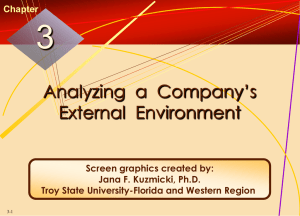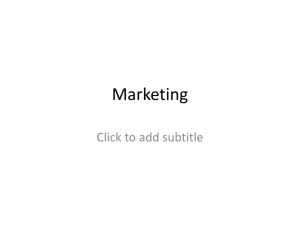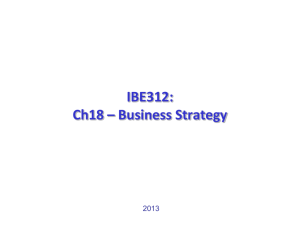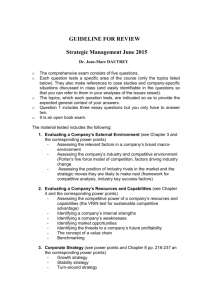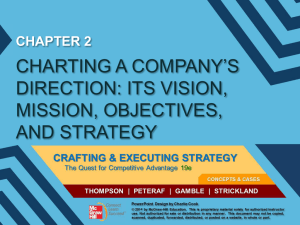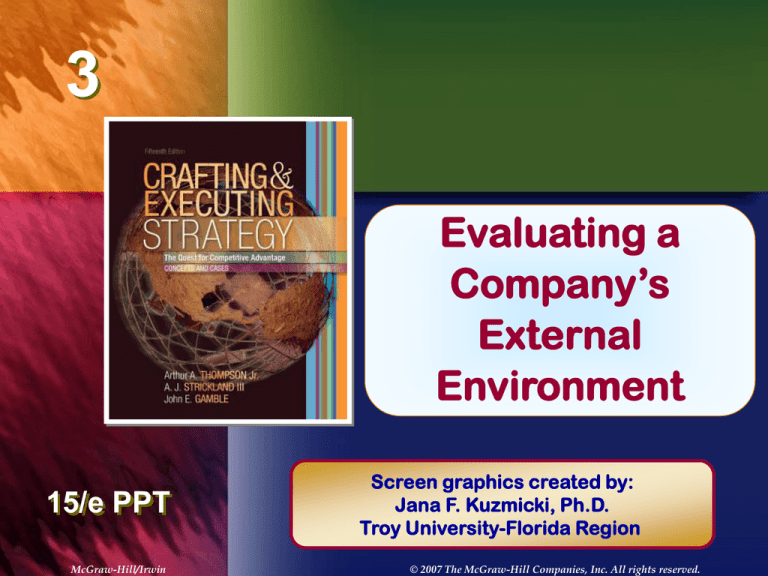
3
Evaluating a
Chapter Title
Company’s
External
Environment
15/e PPT
McGraw-Hill/Irwin
Screen graphics created by:
Jana F. Kuzmicki, Ph.D.
Troy University-Florida Region
© 2007 The McGraw-Hill Companies, Inc. All rights reserved.
Understanding the Factors that
Determine a Company’s Situation
Diagnosing
a company’s situation has two
facets
Assessing
the company’s external or
macro-environment
Industry and competitive conditions
Forces acting to reshape this environment
Assessing
the company’s internal or
micro-environment
Market position and competitiveness
Competencies, capabilities, resource strengths
and weaknesses, and competitiveness
3-2
Fig. 3.1: From Thinking Strategically about the
Company’s Situation to Choosing a Strategy
3-3
Fig. 3.2: The Components of a Company’s Macro-environment
3-4
Thinking Strategically about a
Company’s Macro-environment
A company’s macro-environment includes all relevant
factors and influences outside its boundaries
Diagnosing a company’s external situation involves
assessing strategically important factors that have a
bearing on the decisions a company’s makes about its
Direction
Objectives
Strategy
Business model
Requires that company managers scan
the external environment to
Identify potentially important external developments
Assess their impact and influence
Adapt a company’s direction and strategy as needed
3-5
Key Questions Regarding the
Industry and Competitive Environment
What are the
industry’s
dominant
economic traits?
How strong are
competitive
forces?
What market
positions do
rivals occupy?
What moves will
they make next?
What forces
are driving
change in the
industry?
What are the
key factors for
competitive
success?
3-6
How attractive
is the industry
from a profit
perspective?
Question 1: What are the Industry’s
Dominant Economic Traits?
Market size and growth rate
Number of rivals
Scope of competitive rivalry
Buyer needs and requirements
Degree of product differentiation
Product innovation
Supply/demand conditions
Pace of technological change
Vertical integration
Economies of scale
Learning and experience curve effects
3-7
3-8
Question 2: What Kinds of Competitive
Forces Are Industry Members Facing?
Objectives
Main
sources of competitive forces
Strength
Key
are to identify
of these forces
analytical tool
Five
Forces Model
of Competition
3-9
Fig. 3.3: The Five Forces Model of Competition
3-10
Analyzing the Five Competitive Forces:
How to Do It
Step 1: Identify the specific competitive
pressures associated with each of
the five forces
Step 2: Evaluate the strength of each
competitive force -- fierce, strong,
moderate to normal, or weak?
Step 3: Determine whether the collective
strength of the five competitive forces
is conducive to earning attractive profits
3-11
Fig. 3.4: Weapons for Competing and Factors
Affecting Strength of Rivalry
3-12
Fig. 3.5: Factors Affecting Threat of Entry
3-13
Fig. 3.6: Factors Affecting Competition From Substitute Products
3-14
Fig. 3.7: Factors Affecting Bargaining Power of Suppliers
3-15
Fig. 3.8: Factors Affecting Bargaining Power of Buyers
3-16
Question 3: What Factors Are Driving Industry
Change and What Impacts Will They Have?
Industries
change because forces
are driving industry participants
to alter their actions
Driving
forces are the
major underlying causes
of changing industry and
competitive conditions
Where
do driving forces originate?
Outer
ring of macroenvironment
Inner
ring of macroenvironment
3-17
3-18
Question 4: What Market Positions
Do Rivals Occupy?
One
technique to reveal
different competitive positions
of industry rivals is
strategic group mapping
A strategic
group is a
cluster of firms in an industry
with similar competitive
approaches and market positions
3-19
Strategic Group Mapping
Firms
in same strategic group have two or more
competitive characteristics in common
Have comparable product line breadth
Sell in same price/quality range
Emphasize same distribution channels
Use same product attributes to appeal
to similar types of buyers
Use identical technological approaches
Offer buyers similar services
Cover same geographic areas
3-20
Question 5: What Strategic Moves Are
Rivals Likely to Make Next?
A firm’s
best strategic moves are affected by
Current strategies of competitors
Future actions of competitors
Profiling
key rivals involves gathering
competitive intelligence about
Current strategies
Most recent actions and public announcements
Resource strengths and weaknesses
Efforts being made to improve their situation
Thinking and leadership styles of top executives
3-21
Competitor Analysis
Sizing
up strategies and competitive strengths
and weaknesses of rivals involves assessing
Which rival has the best strategy? Which
rivals appear to have weak strategies?
Which firms are poised to gain
market share, and which ones
seen destined to lose ground?
Which rivals are likely to rank among the industry
leaders five years from now? Do any up-and-coming
rivals have strategies and the resources to overtake the
current industry leader?
3-22
Question 6: What Are the Key
Factors for Competitive Success?
KSFs are those competitive factors most affecting
every industry member’s ability to prosper
KSFs concern
Specific strategy elements
Product attributes
Resources
Competencies
Competitive capabilities
that a company needs to be competitively successful
KSFs are attributes that spell the difference between
Profit and loss
Competitive success or failure
3-23
3-24
Question 7: Does the Outlook for the Industry
Present an Attractive Opportunity?
Involves
assessing whether the industry
and competitive environment is attractive
or unattractive for earning good profits
Under
certain circumstances, a firm uniquely
well-situated in an otherwise unattractive
industry can still earn unusually good profits
Attractiveness is relative, not absolute
Conclusions about attractiveness have
to be drawn from the perspective of a
particular company
3-25

